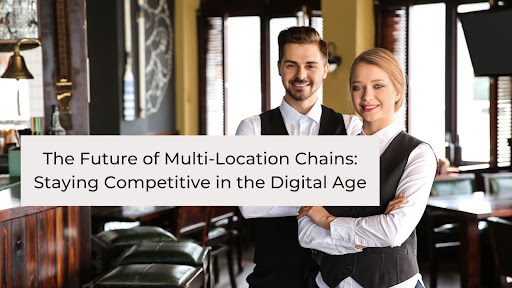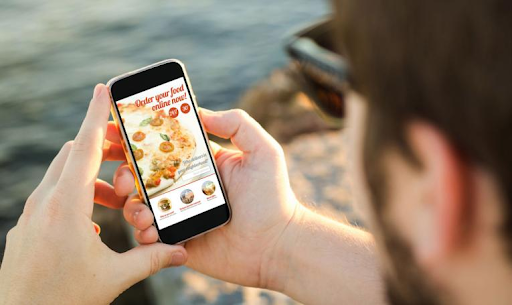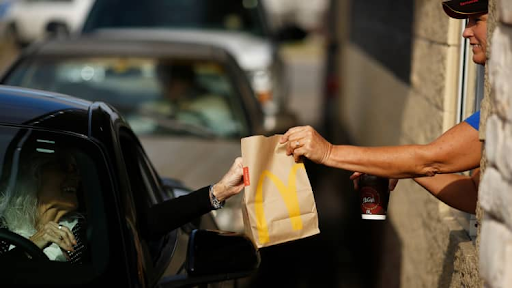The Future of Multi-Location Chains: Staying Competitive in the Digital Age

Being omnipresent makes a business, especially a restaurant chain, successful in today’s world of fierce competition. Outlets that have become global brands like KFC, Pizza Hut, Starbucks, and many more are now sitting at million-dollar worth because of their worldwide presence and, of course, delectable food.
If you also wish to own one such globally available chain or already have a presence at two or more locations in and around your vicinity, you need to be backed by efficient technology.
Yes, surviving in today's digital era with insufficient technology is out of the question for any business. So, we have decided to decode some trends and technology that will embolden a multi-location chain so much that handling orders, customers, inventory, and everything else becomes a child’s play.
The Rise of Multi-Location Chains- Reality Check
Entering the restaurant industry is easy. What’s tough is surviving and growing. Before you step into this world, you need to understand the harsh reality of this world. The impact of COVID-19 has decreased. Yet, this industry is dealing with other challenges.
Do you know that one in three restaurants only fail in its first year?
And this downfall is not because of a single reason. Multiple factors contribute to it. To begin with, maintaining food quality and service standards and delivering the same customer experience across all chains is a huge challenge for any multi-location restaurant.
Location plays a crucial role in the success of multi-location chains. They must carefully pick the location to experience the same revenue and public attention. We all know Starbucks is known for its lip-smacking drinks. But the Starbucks Reserve Roastery in Milan is the best of all. Why? It's located in an awe-striking location. But finding the right place is not always possible.
Unless all these multi-location chains are not operated as a franchise system and are under one administration, having effective communication is a big challenge for any restaurant. There should be seamless communication and data exchange between vendors and staff to avoid confusion.
Multi-location chains must work on their menu while keeping local tastes in mind. They have some standard food items across all the locations, but certain menu customization according to the local palate is necessary. All the big brands have done that. You can have nachos with salsa, cheese, chips, and tortillas in KFC Australia, while only KFC Thailand serves scrumptious green curry chicken rice bowls. This is why they have to work extensively on menu customization.
This is not the end of it. As you step into the world of multi-location chains, you will realize specific gains and losses on your own. However, these challenges shouldn't push you away. As you aspire to grow and expand, you must know how to combat these challenges.
The right kind of technology stack for restaurants can fix tons of them. Let’s review the technology and trends shaping the future of multi-location chains.
What’s Driving the Future of Multi-Location Chains?
Multiple factors are contributing towards a better and brighter future for multi-location chains. We listed the most crucial ones.
1. Multi-location chains are now becoming multi-purpose
Gone is the era of restaurants that only serve delicious food. Multi-location chains are now becoming multi-purposed. Diners prefer having their meal where they get entertainment, have their favorite drinks, and can even watch their most-liked shows or movies. They are now looking for a wholesome dining experience, and multi-location chains offering this experience are doing great.
The biggest example of this is the Starbucks Reserve Roastery in Milan. It will teleport you into a different world when you step into it. It’s a dine-in museum for coffee lovers. You can choose from over 150 Starbucks drinks and delve into a 360° coffee experience. People can’t stop clicking at its awe-striking ambiance. Here, they get more than coffee, which is why it’s one of the most famous Starbucks ever. So, you should start making a move in this direction.
2. Managing everything from anywhere and at any time with the help of a powerful tool remains the top priority
When you’re handling the ownership of 5-10 multi-location chains, you need to have a reliable and feature-rich tool to help you manage inventory, orders, customer loyalty, delivery, and content for your restaurant.
Having the right kind of restaurant-industry-specific technology improves the efficiency of 95% of operators.
The right kind of inventory management software can help restaurants reduce overstocking mistakes by 17%. An all-inclusive tool like OrderEm can help multi-location chains optimize their inventory, streamline online order processing, track delivery in real-time, and do much more.
3. Having a mobile app will do wonders

People using mobile apps to order food have jumped to 49.5 million from 36.4 million from 2019 to 2021. 32% of customers prefer ordering food directly from a restaurant's mobile app.
These statistics make one thing clear: multi-location chains need to have the aid of dedicated custom mobile apps if they wish to approach their targeted customers better. With the help of this resource, such restaurants can be at their customers' fingertips. So, if you’re not using a custom mobile app, go and get it.
4. Using AI for Local SEO is the need of the hour
When you want to dominate each of your chain’s locations, you need to get noticed by the locals, and local SEO will make it happen. Multi-location brands are using AI to understand how Google surfaces local SERPs.
With the help of AI, multi-location chains are automating image categorization, audience insights, and fine-tuning their marketing strategies according to the local audience. AI is useful to strengthen local SEO efforts and can help multi-location chains understand consumer behavior.
5. Drive-throughs, curbside pick-ups, and BOPIs are not going anywhere

Even though the pandemic is not as minuscule as it used to be, people are still following the pandemic-induced shopping and dining experience. 59% Of millennials prefer restaurant takeout or deliveries for their restaurant orders.
74% of customers feel restaurants should offer deliveries as a future growth strategy. 63% of customers find order delivery more convenient than dine-in. So, you must be functional as a drive-through, pick-up, online order, and BOPI.
6. Optimize your chains for ‘Near me’ searches and make them voice-assisted ready
If you want to get spotted by locals, be ready with details like menu, review, hours, sides, coupons, and many more, and enable it for voice-assisted. Voice-based search is rising, and you must ensure that your restaurant shows up in the search results.
7. Supply chain disruptions are still there
The struggle with supply chain disruption will continue for multi-location chains in 2023 and beyond. Supply chain shortages impact every kind of restaurant, and multi-location chains must deal with them a little more. Potato prices took a jump of 63% from last year; the same is true with other ingredients. The high ingredient price remains a challenge for both brands and budding restaurants.
They must find a way to continue generating sales despite the fluctuating prices. One possible way out is to have menu items that can be easily cross-utilized.
Final Say
Brands are built from multiple locations, and as the owner of a multi-location chain, you need to stay updated with current trends and technologies. The power of automation that a restaurant management tool brings can’t be overlooked when discussing seamlessness in all workflows at all locations.
So, get yourself an inventive tool such as the one from OrderEm, leverage the power of AI for local SEO, tweak your menus to deal with supply chain challenges, and weave success. Good Luck!